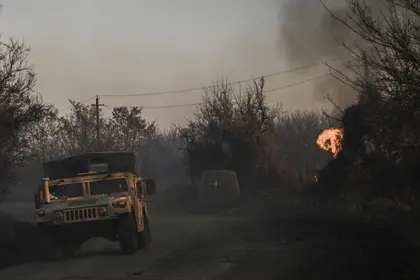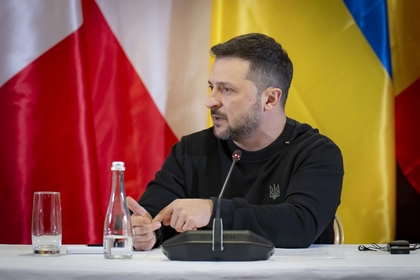Russian forces are using chemical weapons against Ukrainian troops, a spokesman for the Ukrainian Defense Forces has claimed.
Col. Oleksiy Dmytrashkivsky said that following an artillery strike against Ukrainian positions near the Donbas city of Bakhmut, soldiers showed symptoms including nausea, vomiting and, in a few cases, loss of consciousness.
“During the artillery bombardments they use a chemical called lewisite,” Dmytrashkivsky said in a video posted on social media.
Ukrainian chemical warfare specialists were still evaluating evidence and identification of lewisite as the chemical weapon used was preliminary, Dmyrtrashkivsky said.
By mid-afternoon on Tuesday Dmytrashkivsky’s statement was rapidly going viral across Ukrainian mass media, but the claims had yet to be independently verified.
Kyiv Post spoke to a member of Ukraine’s reserve forces who, speaking on background, said he was not surprised the alleged chemical attack had taken place.
Ukrainian army chemical weapons defense teams have trained continually since Russia’s full-scale invasion of Ukraine in February 2022, and the Armed Forces of Ukraine (AFU) has always considered Russian chemical attack a real possibility, he said.
What is lewisite?
First used in combat during World War I, lewisite is a chemical compound commonly called vesicant or blistering agent, because it causes blistering on the skin and mucous membranes on contact.

Ukraine: Putin Confirms Attack with New Missile
In its pure form it appears as an oily, colorless liquid but when used in weapons its color can range from amber to black.
Lewisite is said to smell of geraniums. Its only use is as a chemical warfare agent, typically delivered by artillery shells or, less commonly, by aerial bombs. The compound has no other medical or practical use.
Signs and symptoms follow from exposure. These typically include:
• Skin pain and irritation within seconds of contact which will redden within 15 to 30 minutes then becoming blistered after several hours;
• Eyes will suffer immediate irritation, pain, swelling, and tearing on contact;
• Respiratory tract starts with runny nose which will quickly turn to sneezing, hoarseness, bloody nose, sinus pain, shortness of breath, and cough;
• Digestive tract will react with diarrhea, nausea, and vomiting after minutes or hours;
• Cardiovascular system will exhibit “lewisite shock,” which appears as very low blood pressure.
Lewisite exposure treatment consists of cleaning the chemical from the body as soon as possible and administering medical care in a hospital setting.
An antidote for lewisite, called dimercaprol, and also known as British Anti-Lewisite (BAL), was invented during World War I.
The antidote BAL is administered by an intramuscular injection and, if given in sufficient time, will decrease the toxicity of the chemical in the body.
The antidote will not repair damage to skin, eyes, or airways, which would require other medical intervention.
Reports of potential chemical weapons use in the war have cropped up intermittently but, thus far, without independent confirmation. The most widely reported incident took place in April 2022, when Ukrainian troops defending the Azovstal steel mill in the besieged city Mariupol reported Russian use of a gas causing mucous irritation, asphyxiation and nausea.
Ukrainian officials echoed the claim Russian artillery had used chemical weapons against Mariupol’s defenders and gunners firing the shells were responsible for war crimes.
Moscow officials subsequently claimed the Russian military respects the rules of war and that allegations about chemical weapons use in Mariupol was Ukrainian or NATO propaganda.
The chemical white phosphorus – an agent with the primary military uses of making smoke and setting fires, but fully capable of killing individuals by severe burns or asphyxiation – has been used by both sides in the war.
Russian army general Sergei Surovikin, the commander of the Kremlin’s brutal assault on Mariupol, and the senior officer in the Russian campaign to level the Syrian city Aleppo, in public statements described white phosphorus as an excellent weapon with which to reduce civilian structures and military defenses alike.
Drone operators on both sides of the Russo-Ukrainian War have from time to time attempted attacks against enemy trenches using tear gas (CS) grenades. CS gas is not commonly used in grenade-drop drone attacks, due to the relatively small amount of CS gas in a grenade and more lethal results dropping conventional hand grenades or modified mortar shells.
On Monday and Tuesday, officials in Kyiv and Moscow traded repeated accusations that the other side was preparing to use a weapon of mass destruction. The most common scenario was a nuclear incident following intentional destruction of the Russian-occupied Zaporizhzhia nuclear power station, near the city Kakhovka, but some Russia-supporting information platforms predicted a chemical weapons-related incident.
On Tuesday, the Moscow-loyal Kherson Vestnik Telegram channel claimed the Ukrainian government intended to manufacture a chemical weapons incident using barrels of chlorine against unsuspecting Ukrainian troops. The platform did not offer evidence.
Chemical Weapons Convention
The Chemical Weapons Convention (CWC), which is officially called the Convention on the Prohibition of the Development, Production, Stockpiling and Use of Chemical Weapons and on their Destruction, came into into force on April 29, 1997.
Per the treaty, holders of such weapons were obliged to commence verified destruction of all current chemical weapons, other than small amounts to be retained for testing or development of defensive countermeasures. All destruction activities were to take place under OPCW (Organisation for the Prohibition of Chemical Weapons) verification.
Currently 193 states, including Russia are signatories of the convention and have (supposedly) accepted their obligations to the treaty. Russia claimed to have destroyed the balance of its chemical weapons in 2017.
British law enforcers and courtrooms have confirmed the Kremlin violated that commitment, at minimum, in March 2018 attacks against the former KGB officer, Sergei Skripal, in the UK city of Salisbury. The Kremlin denied wrongdoing.
Prominent Russian opposition activist Alexei Navalny in the Siberian city of Omsk in August 2020 was poisoned by the Russia-developed “Novichok” nerve agent. He survived.
The Kremlin has denied responsibility for the attempted assassination. Moscow officials denied wrongdoing and claimed Navalny’s illness was probably because of something he ate.
You can also highlight the text and press Ctrl + Enter






